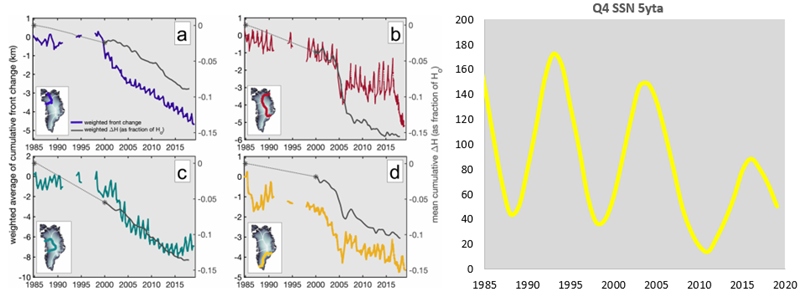In a previous post I speculated that contrary to conventional notions, a cooling Sun might shrink glaciers and raise sea levels. I suggested that less solar radiation (as signified by lower sunspot numbers, SSNs) leads most significantly to less evaporation of moisture from the oceans. With less water in the atmosphere, there would be less precipitation over high altitude and high latitude catchments. With less precipitation over those regions, I proposed that snow packs and glaciers would actually shrink, in spite of decreasing temperatures.
Moreover, with less evaporation of moisture from the oceans, and the resulting drop in moisture sequestration within glaciers and ice fields, the sea level would be expected to accordingly rise over time.
I understand that this is exactly the opposite of the narrative that experts appear to hang onto. Yet even works by those experts appear to support my notion. The featured image is a great example.
Prominently featured in major media including CNN, the Greenland ice study by King et al. (2020) [1], is compared to the decline in solar radiation (as signified by the 5 year trailing average of SSNs) in my featured image. As sunspot numbers have declined, so have the vast masses of ice across Greenland.
I’ve explored the paper somewhat further, and note that they make no mention of solar forcing effects. To their credit they don’t refer to “climate change” or “global warming”* either. They leave that to common media.
I also think it is interesting that the glacier study team do not attempt to work further back in time prior to 1985. That’s partly understandable given their primary focus on the satellite era, but I’d be interested to know if possible how the Greenland ice sheet fared in the 1950s through the 1970s. Perhaps that is challenging to accurately determine because then as now, the entire island has remained covered in ice, and the minor mass balance changes are so subtle, only constant satellite observation and integration might capture the differences.
I haven’t engaged in the careful study of Greenland as these obviously thorough researchers have. I support continued investigations along their lines so long as they pay more taxpayer funded attention to solar influences.
References
[1] King, M.D., Howat, I.M., Candela, S.G., Noh, M.J., Jeong, S., Noel, B.P.Y., van den Broeke, M.R., Wouters, B., and Negrete, A. 2020. Dynamic ice loss from the Greenland Ice Sheet driven by sustained glacier retreat. Communications Earth&Environment (2020) 1:1 | https://doi.org/10.1038/s43247-020-0001-2 | www.nature.com/commsenv
*The authors do nominally reference a paper which has “global warming” in its title, but as usual, that is another modeling study, which hardly merits attention.
 8311total visits,7visits today
8311total visits,7visits today
